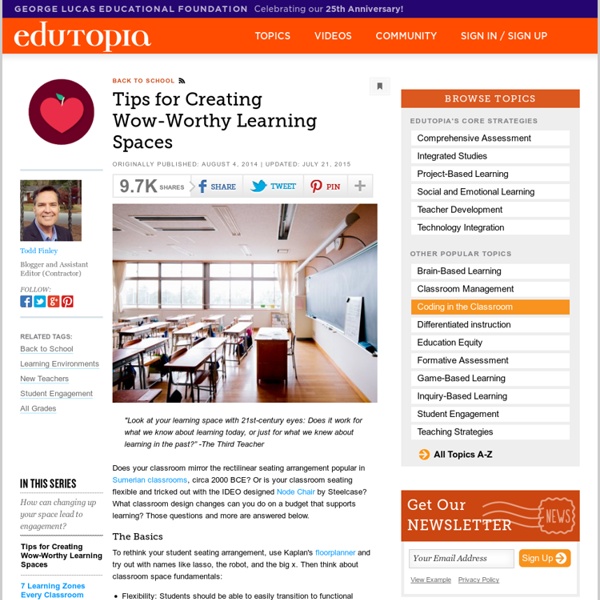



The Science of Effective Learning Spaces If you’ve ever attempted to clear your head by taking a walk outside or zoning out by a window as the clouds roll by, you’ve intuitively hit on something that scientists have been researching for years: Our natural and built environments seem to affect how we think and feel. Researchers have recently focused on determining how environmental factors can affect kids’ ability to learn. Studies show that a well-designed learning environment supplements evidence-based pedagogy and curriculum design. Let’s examine four environmental factors that can enhance or hinder learning. Daytime Light Exposure Can Boost Learning Light does more than just allow us to see the world around us. Even more importantly, all light is not the same. One study of 21,000 U.S. elementary students showed that, over one school year, kids who were exposed to more sunlight during their school day displayed 26 percent higher reading outcomes and 20 percent higher math outcomes than kids in less sunny classrooms. 1. 2. 3.
August New Teacher Survival Guide | Scholastic.com From setting up your classroom to brainstorming icebreaker activities, these tips and tricks will have you prepped, relaxed, and ready just in time for the first day of school. Preparing Your Classroom Our Easy Guide to Setting Up Your Classroom (K–5) At last, a classroom of your own! Time to roll up your shirtsleeves and begin transforming that empty space into a warm and inviting place for your first class. Here's how. The New Teacher's Crash Course on Setting Up Your Classroom (6–8) Preparing your classroom for the arrival of your students is probably high on the list of your priorities. How to Make an Old Classroom New Again As a new teacher, a big challenge will be setting up your new classroom and making it your own. Clip and Save Checklist: Get Ready for the First Day of School! Fit to Print: Use This Handy Seating Chart A seating chart to start your school year. First Day of School Icebreakers You're not the only one excited and nervous about the first day of school.
7 Learning Zones Every Classroom Must Have There are many elements to consider as you plan for the next school year. You always review critical pieces like standards, curriculum, instructional activities, and testing, but you also think about the classroom space and how to arrange desks, set up bulletin boards, and organize materials. You can bring these seemingly disconnected components together in a system of seven classroom zones. 7 Zones for Optimal Classroom Organization 1. Share samples of different projects so that students have a jumping-off point. 7 Essential Classroom Zones 2. 3. You can also use this space for reference materials like formula and vocabulary charts, cheat sheets, study guides, manuals, textbooks, clipboards, and spirals or journals. 4. At the start of the year, you’ll lead the discussions, but students should be guided until they can open, facilitate, and close the meetings. 5. 6. This zone is also your professional space where you plan, prepare, grade, analyze data, and complete your reports. 7.
Morning Meetings: Creating a Safe Space for Learning Alli: Anybody want to share about how they're feeling today? Evan, how are you feeling? Evan: Hungry! Alli: You're feeling hungry. Owen: I'm feeling sleepy, excited and fine. Alli: Wow, you're feeling lots of emotions today. Definitely noticed a change in some of my shyer students. No matter what kind of morning they had at home, they're going to come into my classroom, they're going to sit in a circle and be with their friends. Molly? Student: And I hope you have a great time. Molly: Thank you. Alli: In order to get any kid to learn, they really have to feel safe. The greeting part of Morning Meeting, it really changes day-to-day. So today I'm going to hand you one card. Student: How are you feeling? Student: Okay. Student: Okay, thanks. Alli: The more that you can make the behavioral stuff for your entire classroom, instead of just focusing on individual kids, it really helps those kids not feel so isolated, for things that they're trying to work on. Today is? Students: Wednesday!
The school of the future has opened in Finland Child psychologists have long argued that changing the approach we take to education would help many children learn to love school rather than hate it. We’ve all heard pre-schoolers talk about how they can’t wait to sit at their school desk and run to their next lesson with their rucksack over their shoulder. In fact, we probably remember that feeling of excitement ourselves the first time we went. But right from the first days of school, many children feel a huge sense of disappointment with what they encounter. At the Saunalahti school in the city of Espoo, Finland, they’ve found a brilliant way to overcome this problem. Across its 10,500 square metres, there’s a primary school, a secondary school, a kindergarten, a youth club, theatre, cafeteria, library, gym and many other things. The pupils are allowed to move around the classroom on their miniature office chairs (remember how much your teachers used to tell you off for that?)